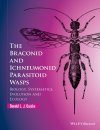About this book
The Ichneumonoidea is a vast and important superfamily of parasitic wasps, with some 60 000 described species and estimated numbers far higher, especially for small-bodied tropical taxa. The superfamily comprises two cosmopolitan families – Braconidae and Ichneumonidae – that have largely attracted separate groups of researchers, and this, to a considerable extent, has meant that understanding of their adaptive features has often been considered in isolation.
The Braconid and Ichneumonid Parasitoid Wasps considers both families, highlighting similarities and differences in their adaptations. The classification of the whole of the Ichneumonoidea, along with most other insect orders, has been plagued by typology whereby undue importance has been attributed to particular characters in defining groups. Typology is a common disease of traditional taxonomy such that, until recently, quite a lot of taxa have been associated with the wrong higher clades. The sheer size of the group, and until the last 30 or so years, lack of accessible identification materials, has been a further impediment to research on all but a handful of 'lab rat' species usually cultured initially because of their potential in biological control. New evidence, largely in the form of molecular data, have shown that many morphological, behavioural, physiological and anatomical characters associated with basic life history features, specifically whether wasps are ecto- or endoparasitic, or idiobiont or koinobiont, can be grossly misleading in terms of the phylogeny they suggest. The Braconid and Ichneumonid Parasitoid Wasps shows how, with better supported phylogenetic hypotheses entomologists can understand far more about the ways natural selection is acting upon them.
The Braconid and Ichneumonid Parasitoid Wasps covers the same areas as Parasitic Wasps (Springer, 1997) (behaviour, physiology, development, anatomy, venoms, sex, ecology and evolution), but they have been brought up to date in The Braconid and Ichneumonid Parasitoid Wasps (much new data has become available over the intervening years). This new book also focuses on this superfamily with which the author has great familiarity and provides a detailed coverage of each subfamily, emphasising anatomy, taxonomy and systematics, biology, as well as pointing out the importance and research potential of each group. Fossil taxa are included and it also has sections on biogeography, global species richness, culturing and rearing and preparing specimens for taxonomic study.
The Braconid and Ichneumonid Parasitoid Wasps highlights areas where research might be particularly rewarding and suggests systems/groups that need investigation. The author provides a large compendium of references to original research on each group. The Ichneumon Wasps is an essential workmate for all postgraduates and researchers working on ichneumonoid or other parasitic wasps worldwide. It will stand as a reference book for a good number of years, and while rapid advances in various fields such as genomics and host physiological interactions will lead to new information, as an overall synthesis of the current state it will stay relevant for a long time.
Contents
Chapter 1 Introduction
Chapter 2 Adult external morphology
Chapter 3 The ovipoistor and ovipositor sheaths
Chapter 4 Internal and reproductive anatomy
Chapter 5 Immature stages
Chapter 6 Idiobionts, koinobionts and other life history traits
Chapter 7 Sex, courtship and mating
Chapter 8 Host location, assessment and associative learning
Chapter 9 Overcoming host immune reaction and physiological interactions with hosts
Chapter 10 Convergent adaptations
Chapter 11 Overview of Ichneumonoidea: relationships and systematics
Chapter 12 Phylogeny and systematics of the Braconidae
Chapter 13 Phylogeny and systematics of the Ichneumonidae
Chapter 14 Ecology
Chapter 15 Local and global patterns in diversity
Chapter 16 Collecting and rearing Ichneumonoidea
Chapter 17 Epilogue
Customer Reviews
Biography
Donald L. J. Quicke is currently Visiting Professor at the Department of Biology, Faculty of Science, Chulalongkorn University, Thailand. He graduated from Oxford University with a degree in zoology and after doctoral and postdoctoral work on snail neurophysiology, sea anemone ecology and spider venoms, made parasitic wasps, and especially the ichneumonoid wasp family Braconidae, his main love and research interest. He held a lectureship at Sheffield University, moved to Imperial College London in 1993 and held a joint post between them and the Natural History Museum, London, until retiring in 2013 to live in Thailand. He was made Professor of Systematics in 2008. He has travelled widely collecting and studying parasitic wasps, especially in Africa. Over the past years he has described more than 560 new species and 76 new genera, including a number of fossil taxa, as well as making extensive studies of functional anatomy parasitic wasp ovipositors which are of enormous biological importance. A lot of his recent work has concerned global diversity estimation and patterns.







































